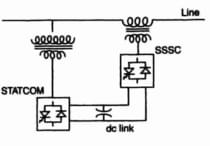Static Shunt Compensators
1. Shunt connected, fixed or mechanically switched _________ are applied to minimize line overvoltage under light load conditions.
a. Impedance
b. Reactor
c. Capacitors
d. Converter
2. Shunt connected, fixed or mechanically switched _________ are applied to maintain voltage levels under heavy load conditions.
a. Impedance
b. Capacitors
c. Converter
d. Reactor
3. The ultimate objective of applying reactive shunt compensation in a transmission system is to increase the _______________.
a. Reactance
b. Current
c. Transmittable power
d. Voltage
4. Var compensation is thus used for voltage regulation at the ____________ to segment the transmission line and at the ______of the (radial) line to prevent voltage instability.
a. End, Mid
b. Start, End
c. Start, Mid
d. Mid, End
5. A transmission line connecting two systems, the best location for var compensation is in the______.
a. Middle
b. Starting
c. Ending
d. No where
6. Which year the first STATCOM was implemented?
a. January 1980
b. January 1981
c. January 1983
d. January 1985
Midpoint Voltage Regulation for Line Segmentation
1. Two-Machine System (Without Compensator)
Please, Do remember formula of Active Power and Reactive power of without compensator.
6. For a radial feed to a load the best location is at the _______.
a. Load End
b. Starting
c. Mid
d. No where
1. AC power transmission over long lines was primarily limited by the _____________ of the line.
a. Shunt impedance
b. Series impedance
c. Series reactive impedance
d. Shunt reactive impedance
The basic idea behind series capacitive compensation is to decrease the overall effective series transmission impedance from the sending end to the receiving end, i.e., 𝑋 in the P.
2. For increasing the voltage stability limit of overhead transmission, ____________ is much more effective than ______________ of the same MVA rating.
a. Shunt compensation, Series compensation
b. Series compensation, Shunt compensation
3. The series compensator is a ______________ of the shunt compensator.
a. Nonreciprocal
b. Directly proportional
c. Reciprocal
d. Integral
4. The shunt compensator is functionally a controlled reactive current source which is connected in parallel with the transmission line to control its _________.
a. Voltage
b. Current
c. Power
d. Transient
5. The series compensator is functionally a controlled voltage source which is connected in series with the transmission line to control its ____________.
a. Current
b. Voltage
c. Power
d. Transient
6. In TSSC the degree of series compensation is controlled in a step-like manner by increasing or decreasing the number of series _________ inserted.
a. Resistor
b. Inductor
c. Capacitor
d. Diode
7. In TSSC a __________ is inserted by turning off, and it is bypassed by turning on the corresponding thyristor valve.
a. Resistor
b. Inductor
c. Capacitor
d. Diode
8. The TSSC could be applied for power flow control and for damping power oscillation where the required speed of response is ____________.
a. Slow
b. Moderate
c. Fast
d. Ultra-fast
9. The SSSC use ________ thyristors.
a. SCR
b. DIAC
c. TRIAC
d. GTO
10. The TSSC employs _________ thyristors.
a. DIAC
b. GTO
c. Conventional
d. MCT
11. The SSSC requires a coupling transformer, rated for _____ p.u. of the total series var compensating range.
a. 0.1
b. 0.3
c. 0.4
d. 0.5
12. The TSSC is coupled _________ to the transmission line.
a. By Capacitor
b. By Inductor
c. Directly
d. By coupling transformer
- MCQs on FACTS Page 1
- MCQs on FACTS Page 2
- MCQs on FACTS Page 3
- MCQs on FACTS Page 5
- MCQs on FACTS Page 6
- MCQs on FACTS Page 7
- MCQs on FACTS Page 8












0 Comments
If you have any doubt, feel free to ask.